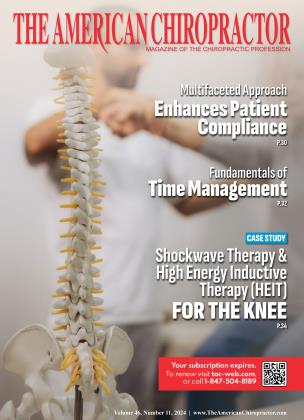Photobiomodulation Therapy for the Promotion of Wound Healing
IN BRIEF
LASER THERAPY
Ryan Novak
DC
Wound care is not a service provided in the typical chiropractor’s office. However, when providing peripheral neuropathy treatment services to diabetic patients, you will encounter diabetic foot wound ulcers (DFWU). Photobiomodulation therapy (PBMT) is an effective adjuvant treatment for DFWUs and neuropathy symptoms.
Before treating a DFWU, it is important to conduct a thorough examination with the appropriate diagnostic tests because it is a multifaceted clinical problem requiring a comprehensive treatment plan for long-term success. DFWUs are always associated with peripheral artery disease or neuropathy and are involved in more than 60% of nontraumatic amputations in the Western world.1
In a double-blind, randomized controlled-placebo control study conducted in 2009 at the University of Ribeirao in Brazil, patients with chronic nonhealing DFWU that failed to respond to other therapies were treated with either a fluence of U/cm2, placebo group, or 3J/cm2 with a combination of 660nm and 890nm PBMT and 1% silver sulfadiazine twice a week. By day 90, 58.3% of the 3J/cm2 PBMT group had completely healed, and 75% had achieved greater than 90% healing of their DFWU.2
In a 2021 meta-analysis, 13 randomized controlled trials with a total of 413 patients were analyzed on the effects of low-level laser therapy (LLLT) for DFWUs. Results in all these trials revealed that LLLT was an effective adjuvant for the acceleration of DFWU healing. The most common spectrum of wavelengths used was 630-904nm, with an average fluence of 2J/cm2, and treatments were performed daily to three times a week for 15 days to 20 weeks.3
In the first study, only PBMT with noncoherent, light-emitting diodes (LED) was used because DFWUs are superficial (at the skin surface) and do not require PBMT with coherent lasers to achieve positive clinical outcomes. Also, from clinical experience, proper wound care and applying topical agents to control infection and speed up new tissue growth will rapidly accelerate treatment outcomes when combined with PBMT.
Dr. Ryan Novak is a practicing naturopathic and chiropractic physician. He is also the chief scientific officer (CSO) for a sonophotobiomodulation therapy medical device facility and consulting firm that develops and distributes FDA-approved and registered devices, such as the PainBuster Super Pulsed Laser. He can be reached by phone at 877-799-7477 or by visiting PainBusterPro.com.
References
1. Wang X, Yuan CX, Xu B, Yu Z. Diabetic foot ulcers: classification, risk factors and management. World J Diabetes. 2022 Dec 15;13(12):1049-1065. doi: 10.4239/wjd.vl3.il2.1049. PMID: 36578871; PMCID: PMC9791567.
2. Minatel DG, Frade MA, Franca SC, Enwemeka CS. Phototherapy promotes healing of chronic diabetic leg ulcers that failed to respond to other therapies. Lasers SurgMed. 2009 Aug;41(6):433-41. doi: 10.1002/lsm.20789. PMID: 19588536.
3. Huang J, Chen J, Xiong S, Huang J, Liu Z. The effect of low-1 evel laser therapy on diabetic foot ulcers: a meta-analysis of randomised controlled trials. Int Wound J. 2021 Dec; 18(6):763-776. doi: 10.1111/ iwj. 13577. Epub 2021 Mar 9. PMID: 33751853; PMCID: PMC8613395.
 View Full Issue
View Full Issue









